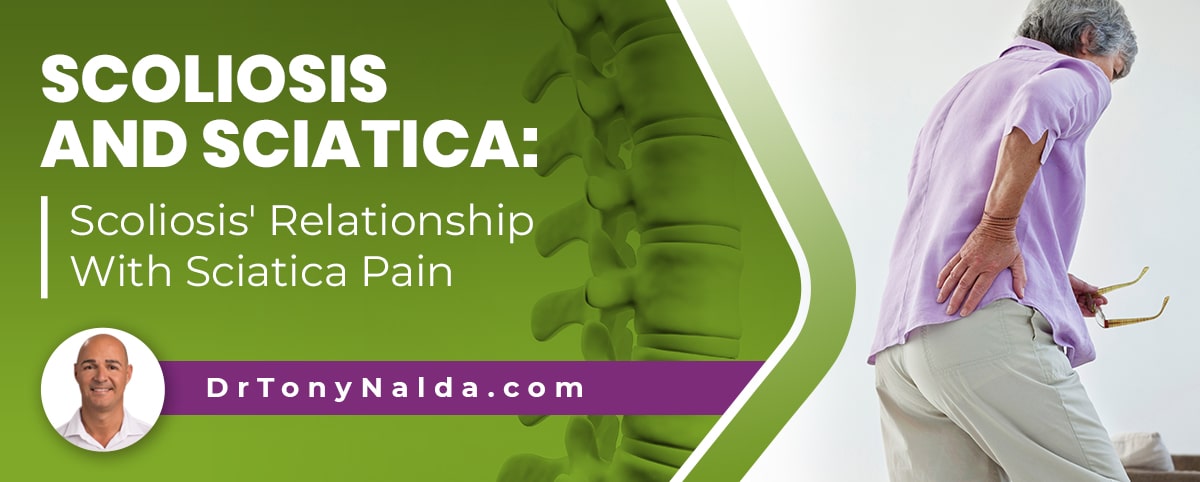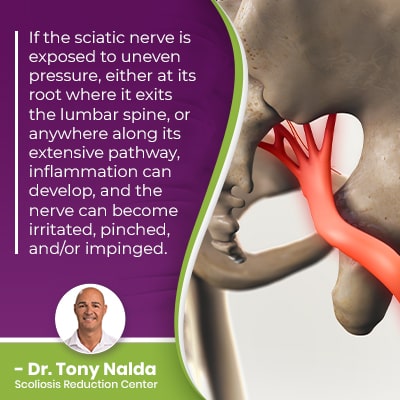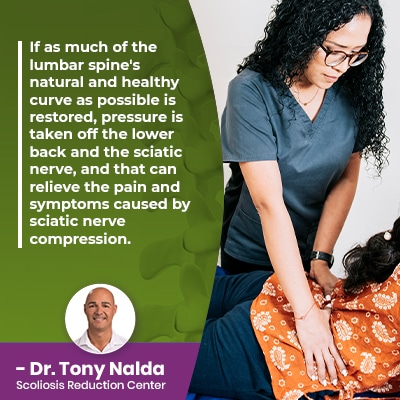Scoliosis and Sciatica: Scoliosis' Relationship With Sciatica Pain

Not only does the spine allow us to stand upright, practice good posture, and engage in flexible movement, it also works with the brain to form the central nervous system (CNS). Each case of scoliosis is unique, but generally, the area of the body most closely located to the affected spinal section is going to feel the condition's direct effects.
Scoliosis can cause a wide range of symptoms felt throughout the body. When the lumbar spine is affected by scoliosis, as the sciatic nerve starts in the lower back, sciatic nerve pain can be a common complication of lumbar scoliosis.
Scoliosis can develop in any of the spine's main sections, or in more than one as a combined scoliosis.
Table of Contents
Anatomy of the Spine
The spine's healthy curves make it stronger, more flexible, and better able to handle mechanical stress incurred during activity.
If the spine's natural and healthy curves are in place, it can function as designed, but if it loses one or more of those healthy curves, the spine's overall strength, function, and biomechanics are disrupted.
The spine has three main sections, and scoliosis can affect any: cervical spine (neck), thoracic spine (middle/upper back), and lumbar spine (lower back).
The most common section affected by scoliosis is the thoracic spine, which makes sense as this is the largest spinal section.
In addition, scoliosis can develop in more than one spinal section as a combined scoliosis; for example, thoracolumbar scoliosis develops in the upper lumbar spine and the lower thoracic spine.
If the spine's healthy curves are in place, its vertebrae (bones) are aligned and stacked on top of one another in a straight and neutral alignment, but if an unnatural curve develops, the vertebrae at its apex are unnaturally tilted, causing the spine to become misaligned.
A misaligned spine can cause a number of issues that can increase over time.
Defining Scoliosis
Scoliosis is the development of an unnatural sideways spinal curvature that also rotates, making it a 3-dimensional condition.
Scoliosis doesn't just affect the spine but also its surroundings, and as part of the central nervous system, the spine is involved in the function of most systems at work, and parts, within the body.
As scoliosis develops, it's exposing the body to uneven forces, and those effects can be felt throughout.
The condition's uneven forces can disrupt the body's overall symmetry, which is why the main scoliosis symptom in children is postural changes such as uneven shoulders and hips.
The main scoliosis symptom in adult patients is pain, and this is because scoliosis becomes compressive in adulthood once skeletal maturity is reached; it's compression (uneven pressure) of the spine and its surrounding muscles and nerves that causes the majority of condition-related pain and complications, like sciatica.
The most important decision scoliosis patients are faced with is how to respond to a diagnosis with treatment.
Defining Sciatica
While many people think of sciatica as a condition in and of itself, it's more accurate to think of sciatic nerve pain as a symptom.
The sciatic nerve is the longest and largest in the human body, and it originates in the lumbar spine and extends down the hip, buttocks, back of the leg, and into the foot.
The sciatic nerve is also a mixed nerve, containing both motor and sensory fibers, which is why it's involved in movement of the lower body and a variety of sensations.
 Sciatic nerve pain is a symptom of nerve compression. If the sciatic nerve is exposed to uneven pressure, either at its root where it exits the lumbar spine, or anywhere along its extensive pathway, inflammation can develop, and the nerve can become irritated, pinched, and/or impinged.
Sciatic nerve pain is a symptom of nerve compression. If the sciatic nerve is exposed to uneven pressure, either at its root where it exits the lumbar spine, or anywhere along its extensive pathway, inflammation can develop, and the nerve can become irritated, pinched, and/or impinged.
The main symptoms of sciatic nerve compression include:
- Low back pain
- Pain that radiates down the back of the lower body's left side
- Tingling sensations felt throughout the lower body (hip, buttocks, legs, and foot pain)
- Electric shock-like sensations felt throughout the lower body
- Numbness
- Muscle weakness
- Mobility issues with the lower body
- Bowel/bladder issues
While not everyone with lumbar scoliosis will automatically develop sciatic nerve pain, it is a common complication, so let's address the connection between scoliosis and sciatica.
Scoliosis and Sciatica Pain
If scoliosis develops in the lower back, this means an unhealthy spinal curve that bends to the side and also twists unnaturally has developed in the lumbar spine.
As mentioned earlier, the uneven forces of scoliosis don't just affect the spine itself, but also its surroundings, which include any of the 31 pairs of spinal nerves.
In addition, scoliosis, as a progressive condition, has it in its nature to worsen over time, and as it progresses, the scoliotic curve is increasing in size, the spine is becoming increasingly rigid, and condition effects are increasing.
So even if a person is diagnosed with mild lumbar scoliosis, and at that time, it doesn't cause sciatic nerve pain, that doesn't mean the scoliosis will stay at that level, and that sciatica can't develop as a related complication of increasing condition severity.
If scoliosis is causing compression of the sciatic nerve, pain can develop as a result, and if left untreated, it can become more severe.
Sciatic nerve pain is most commonly felt down the body's left side, but it can also affect the right, and rarely involves both.
Sciatic nerve pain can range from mild and intermittent to chronic and debilitating.
Many patients experience flare ups, during which symptoms increase for short periods of time, and then abate.
If left untreated, however, flare-up frequency can increase, sciatic nerve damage can become permanent, and symptoms can become more severe, disruptive, and require pain medication.
So if a patient with scoliosis is experiencing sciatic nerve pain as a related complication, what is the best way to address it?
Conservative Treatment for Scoliosis
Conservative treatment for scoliosis combines multiple different forms of condition-specific treatment to impact conditions on every level.
Here at the Scoliosis Reduction Center, if a patient with lumbar scoliosis is experiencing the symptoms of a pinched sciatic nerve, I address it by treating its underlying cause: the scoliosis itself.
As a structural condition, scoliosis has to be primarily impacted on a structural level, and this is worked towards with chiropractic care that includes a series of chiropractic adjustments that, when successful, can reposition the curve's most-tilted vertebrae back into alignment with the rest of the spine, achieving a curvature reduction.
By adjusting the structure of the spine manually, not only are the condition's uneven forces reduced, but pressure is also taken off the spine and its surroundings, which includes its ligaments, muscles, and nerves.
 If as much of the lumbar spine's natural and healthy curve as possible is restored, pressure is taken off the lower back and the sciatic nerve, and that can relieve the pain and symptoms caused by sciatic nerve compression.
If as much of the lumbar spine's natural and healthy curve as possible is restored, pressure is taken off the lower back and the sciatic nerve, and that can relieve the pain and symptoms caused by sciatic nerve compression.
Additional conservative treatments include physical therapy, corrective bracing, and rehabilitation.
If scoliosis is causing pain felt anywhere along the sciatic nerve's pathway, it can be addressed by reducing the size and severity of the scoliotic curve; this is because the sciatica has developed as a secondary complication of scoliosis, so addressing the scoliosis is addressing the sciatic nerve pain's underlying cause.
Conclusion
Scoliosis is a highly-prevalent structural spinal condition that can cause a number of related complications, including sciatica.
While sciatic nerve pain does have causes other than scoliosis such as a herniated disc and/or spinal stenosis, it can be a common complication of lumbar scoliosis by exposing the area in which the sciatic nerve lives to uneven pressure.
As a progressive condition, scoliosis severity can increase over time, as can the condition's symptoms and related complications.
Sciatica is not a condition itself, but is a symptom of sciatic nerve compression that when caused by scoliosis, needs to be addressed by addressing the sciatica's underlying cause: the unnatural scoliotic curve.
An abnormal curvature of the spine can cause a number of issues from mild pain to severe pain, a pinched nerve, related burning sensation, spinal misalignment, upper or lower back pain, numbness, and mobility issues that can make simple tasks challenging.
There are different treatment options for scoliosis, and conservative treatment plan results have proven that most cases of scoliosis can be treated without invasive spinal surgery.
If scoliosis is impacted on a structural level in the form of a curvature reduction, the condition's uneven forces are also being reduced, as are their effects, and related symptoms and complications such as sciatica pain.
Dr. Tony Nalda
DOCTOR OF CHIROPRACTIC
After receiving an undergraduate degree in psychology and his Doctorate of Chiropractic from Life University, Dr. Nalda settled in Celebration, Florida and proceeded to build one of Central Florida’s most successful chiropractic clinics.
His experience with patients suffering from scoliosis, and the confusion and frustration they faced, led him to seek a specialty in scoliosis care. In 2006 he completed his Intensive Care Certification from CLEAR Institute, a leading scoliosis educational and certification center.
About Dr. Tony Nalda
 Ready to explore scoliosis treatment? Contact Us Now
Ready to explore scoliosis treatment? Contact Us Now





